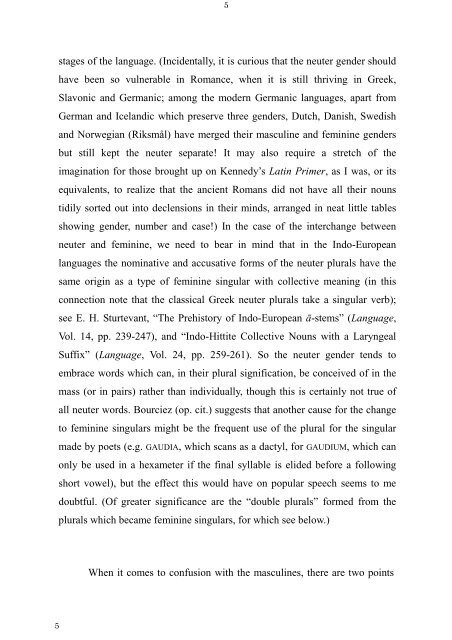The Latin Neuter Plurals in Romance - Page ON
The Latin Neuter Plurals in Romance - Page ON
The Latin Neuter Plurals in Romance - Page ON
You also want an ePaper? Increase the reach of your titles
YUMPU automatically turns print PDFs into web optimized ePapers that Google loves.
5<br />
5<br />
stages of the language. (Incidentally, it is curious that the neuter gender should<br />
have been so vulnerable <strong>in</strong> <strong>Romance</strong>, when it is still thriv<strong>in</strong>g <strong>in</strong> Greek,<br />
Slavonic and Germanic; among the modern Germanic languages, apart from<br />
German and Icelandic which preserve three genders, Dutch, Danish, Swedish<br />
and Norwegian (Riksmål) have merged their mascul<strong>in</strong>e and fem<strong>in</strong><strong>in</strong>e genders<br />
but still kept the neuter separate! It may also require a stretch of the<br />
imag<strong>in</strong>ation for those brought up on Kennedy’s <strong>Lat<strong>in</strong></strong> Primer, as I was, or its<br />
equivalents, to realize that the ancient Romans did not have all their nouns<br />
tidily sorted out <strong>in</strong>to declensions <strong>in</strong> their m<strong>in</strong>ds, arranged <strong>in</strong> neat little tables<br />
show<strong>in</strong>g gender, number and case!) In the case of the <strong>in</strong>terchange between<br />
neuter and fem<strong>in</strong><strong>in</strong>e, we need to bear <strong>in</strong> m<strong>in</strong>d that <strong>in</strong> the Indo-European<br />
languages the nom<strong>in</strong>ative and accusative forms of the neuter plurals have the<br />
same orig<strong>in</strong> as a type of fem<strong>in</strong><strong>in</strong>e s<strong>in</strong>gular with collective mean<strong>in</strong>g (<strong>in</strong> this<br />
connection note that the classical Greek neuter plurals take a s<strong>in</strong>gular verb);<br />
see E. H. Sturtevant, “<strong>The</strong> Prehistory of Indo-European ā-stems” (Language,<br />
Vol. 14, pp. 239-247), and “Indo-Hittite Collective Nouns with a Laryngeal<br />
Suffix” (Language, Vol. 24, pp. 259-261). So the neuter gender tends to<br />
embrace words which can, <strong>in</strong> their plural signification, be conceived of <strong>in</strong> the<br />
mass (or <strong>in</strong> pairs) rather than <strong>in</strong>dividually, though this is certa<strong>in</strong>ly not true of<br />
all neuter words. Bourciez (op. cit.) suggests that another cause for the change<br />
to fem<strong>in</strong><strong>in</strong>e s<strong>in</strong>gulars might be the frequent use of the plural for the s<strong>in</strong>gular<br />
made by poets (e.g. GAUDIA, which scans as a dactyl, for GAUDIUM, which can<br />
only be used <strong>in</strong> a hexameter if the f<strong>in</strong>al syllable is elided before a follow<strong>in</strong>g<br />
short vowel), but the effect this would have on popular speech seems to me<br />
doubtful. (Of greater significance are the “double plurals” formed from the<br />
plurals which became fem<strong>in</strong><strong>in</strong>e s<strong>in</strong>gulars, for which see below.)<br />
When it comes to confusion with the mascul<strong>in</strong>es, there are two po<strong>in</strong>ts









